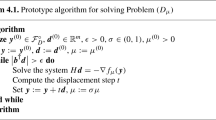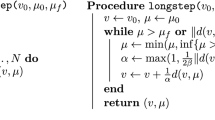Abstract
We present a log-barrier based algorithm for linearly constrained convex differentiable programming problems in nonnegative variables, but where the objective function may not be differentiable at points having a zero coordinate. We use an approximate centering condition as a basis for decreasing the positive parameter of the log-barrier term and show that the total number of iterations to achieve an ε-tolerance optimal solution isO(|log(ε)|)×(number of inner-loop iterations). When applied to then-variable dual geometric programming problem, this bound becomesO(n 2 U/ε), whereU is an upper bound on the maximum magnitude of the iterates generated during the computation.
Similar content being viewed by others
References
Fiacco, A. V., Private Correspondence, 1993.
Rockafellar, R. T.,Convex Analysis, Princeton University Press, Princeton, New Jersey, 1970.
Fiacco, A. V., andMcCormick, G. P.,Nonlinear Programming: Sequential Unconstrained Minimization Techniques, John Wiley and Sons, New York, New York, 1968.
Golstein, E. G.,Theory of Convex Programming, Translations of Mathematical Monographs, American Mathematical Society, Providence, Rhode Island, 1972.
Bazaraa, M. S., andShetty, G. M.,Nonlinear Programming: Theory and Algorithms, John Wiley and Sons, New York, New York, 1979.
Gonzaga, C. C.,Path Following Methods for Linear Programming, SIAM Review, Vol. 34, pp. 167–224, 1992.
Den Hertog, D.,Interior-Point Approach to Linear, Quadratic, and Convex Programming: Algorithms and Complexity, Ph.D. Thesis, Technical University, Delft, Holland, 1992.
Duffin, R. J., Peterson, E. L., andZener, C.,Geometric Programming: Theory and Applications, John Wiley and Sons, New York, New York, 1967.
Anstreicher, K. Den Hertog, D., Roos, C., andTerlaky, T.,A Long-Step Barrier Method for Convex Quadratic Programming, Report No. 90-53, Faculty of Technical Mathematics and Computer Science, Delft University of Technology, Delft, Holland, 1990.
Monteiro, R. D. C., andAdler, I.,An Extension of Karmarkar-Type Algorithm to a Class of Convex Separable Programming Problems with Global Linear Rate of Convergence, Mathematics of Operations Research, Vol. 15, pp. 408–422, 1990.
Kortanek, K. O., Potra, F., andYe, Y.,On Some Efficient Interior-Point Methods for Nonlinear Convex Programming, Linear Algebra and Its Applications, Vol. 152, pp. 169–189, 1991.
Zhu, J.,A Path Following Algorithm for a Class of Convex Programming Problems, Zeitschrift für Operations Research: Methods and Models of Operations Research, Vol. 36, pp. 359–377, 1992.
Den Hertog, D., Roos, C., andTerlaky, T.,On the Classical Logarithmic Barrier Function Method for a Class of Smooth Convex Programming Problems, Computer Science Report No. 90-28, Faculty of Mathematics and Computer Science, Delft University of Technology, Delft, Holland, 1990.
Jarre, F.,The Method of Analytic Centers for Smooth Convex Programs, Dissertation, Institut für Angewandte Mathematik und Statistik, Universität Würzburg, Würzburg, West Germany, 1989.
Nesterov, Y. E., andNemirovsky, A. S.,Self-Concordant Functions and Polynomial Time Methods in Convex Programming, Central Economical and Mathematical Institute, USSR Academy of Sciences, Moscow, USSR, 1989.
Den Hertog, D., Roos, C., andTerlaky, T.,On the Monotonicity of the Dual Objective Along Barrier Paths, COAL Bulletin, Vol. 20, pp. 2–7, 1992.
Kortanek, K. O., andNo, H.,A Second-Order Affine Scaling Algorithm for the Geometric Programming Dual with Logarithmic Barrier, Optimization, Vol. 23, pp. 303–332, 1992.
Kortanek, K. O., andZhu, J.,A Polynomial Barrier Algorithm for Linearly Constrained Convex Programming Problems, Mathematics of Operations Research, Vol. 18, pp. 116–127, 1993.
Abrams, R. A.,Projections of Convex Programs with Unattained Infima, SIAM Journal on Control, Vol. 13, pp. 706–718, 1975.
Avriel, M., andWilliams, A. C.,On the Primal and Dual Constraint Sets in Geometric Programming, Journal of Mathematical Analysis and Applications, Vol. 3, pp. 684–688, 1970.
Gochet, W., Kortanek, K. O., andSmeers, Y.,On a Classification Scheme for Geometric Programming and Complementarity Theorems, Applicable Analysis, Vol. 6, pp. 47–59, 1976.
Bigelow, J. H., DeHaven, J. C., andShapiro, N. Z.,Chemical Equilibrium Problems with Unbounded Constraint Sets, SIAM Journal on Applied Mathematics, Vol. 18, pp. 768–775, 1970.
Kortanek, K. O., Rom, W. O., andSoyster, A. L.,Solution Sets of Convex Programs Related to Chemical Equilibrium Problems, Operations Research, Vol. 21, pp. 240–246, 1973.
Author information
Authors and Affiliations
Additional information
Communicated by A. V. Fiacco
The authors gratefully acknowledge very constructive and insightful comments and suggestions from the two anonymous referees and the correspondence from A. V. Fiacco (Ref. 1).
Rights and permissions
About this article
Cite this article
Kortanek, K.O., Zhu, J. On controlling the parameter in the logarithmic barrier term for convex programming problems. J Optim Theory Appl 84, 117–143 (1995). https://doi.org/10.1007/BF02191739
Issue Date:
DOI: https://doi.org/10.1007/BF02191739




